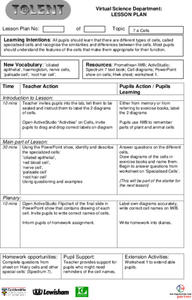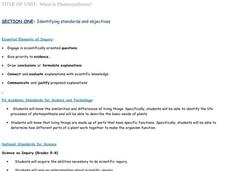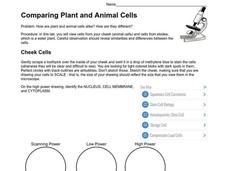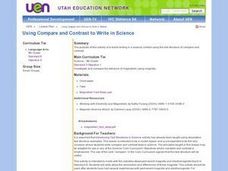Curated OER
Cells
Students explore the types of cells and their appropriate function. After observing a PowerPoint presentation, students draw diagrams of cells. Using a specified website, students identify parts of plant and animal cells. They answer...
Curated OER
What is Photosynthesis?
Students investigate the similarities and differences of living things. Specifically, students will be able to identify the life processes of photosynthesis and describe the basic needs of plants.
Curated OER
Comparing Plant and Animal Cells
In this comparing plant cells and animal cells worksheet, students view cells from their cheeks and cells from elodea. A Venn diagram reveals similarities and differences between the cells.
Curated OER
Where is Shirley the Elephant?
Young animal lovers engage in a lesson that's all about elephants. They access an elephant sanctuary website and read a story about Shirley the elephant. They perform a series of activities based upon that story, and also study about the...
Virginia Department of Education
Elements and Electron Configuration
It's electronic! Pupils uncover elements and their electron configurations as they explore mass, groupings, correct charges, and sliding theory. Young scientists learn creative ways to remember various elements and correctly...
Biology Junction
Mollusks
Mollusks created every shell on Earth. Young scientists learn more about the phyllum mollusca in an informative presentation. It covers their characteristics, body plans, and relationships in the ecosystem. Then, it details each class of...
Bowels Physics
Electric Circuits
Investigate the construction of the electric circuit with a thorough presentation that provides a solid background for each type of circuit. After introducing key vocabulary, the lesson goes on to explain circuit design.
Curated OER
Glaciers
In this glaciers worksheet, students complete 12 different questions related to glaciers. First, they complete the 2 tables that illustrate the similarities and differences between continental and valley glaciers. Then, students identify...
Curated OER
Reflections
Students investigate image and pre-image. In this geometry lesson, students identify the reflection and rotation of different shape on a coordinate plane. They identify similarities and differences of image and pre-image of a reflection.
Curated OER
Communism
Seventh graders study communism. In this world history lesson, 7th graders discuss the similarities and differences between communism and democracies by writing Venn Diagrams.
Curated OER
Surreal Hands
Students compare and contrast various forms of artistic expression. They examine the similarities and differences of how various artists worked.
Curated OER
You Gotta Have A Hat
First graders compare versions of the folktale, 'Caps for Sale.' After listening to both stories, 1st graders utilize a Venn Diagram imbedded in this lesson plan to produce a graphic organizer detailing the similarities and differences...
Curated OER
Everything in Its Place: Science Classification
Students investigate the system of classification for living things through the sixteen lessons of this unit. The five kingdoms of monerans, protists, fungi, plants, and animals form the basis of several experiments as the similarities...
Curated OER
Waddle You Know About Penguins
Second graders study the similarities and differences of the seventeen species of penguins. They investigate habitats and how these habitats are suited to each species characteristics. They see how animals adapt to their environments.
Alabama Learning Exchange
Let's Identify and Classify
Students participate in a creative activity to give them a good understanding of classification. They examine bags of chips and discuss their similarities and differences. Students work in small groups while participating in this activity.
Curated OER
Leadership
Students discuss the dynamic of working in a group and how good leadership skills can aid in the group process. Students discuss the similarities and differences of their group members and brainstorm ways in which these qualities can...
Curated OER
Gingerbread Baby v. Gingerbread Boy #7
Students compare and contrast the gingerbread baby in their story to the original gingerbread boy. They use a Venn diagram to easily see the similarities and differences.
Curated OER
Oceans of the World
Students compare and contrast information about oceans. They locate the oceans on a globe, and in small groups conduct Internet research on the oceans, identifying the similarities and differences and writing a report.
Curated OER
Using Compare and Contrast to Write in Science
Fifth graders investigate and compare the behavior of magnetism using magnets. In this physics instructional activity, 5th graders write about the similarities and differences of a variety of magnet types.
Curated OER
Arctic vs. Antarctic
Students describe the properties of the Arctic and the Antarctic. They write a report citing the similarities and differences of the two regions. They make a Venn diagram showing what they know about each.
Curated OER
Canaima
Students analyze the meaning and uses of definite articles in Spanish. They read a pamphlet on the national park in Canaima, Venezuela, and discuss the similarities and differences between national parks in the U.S. and Venezuela.
Curated OER
Changes of Musical Elements in Popular Music Through the Decades
Learners probe samples of European classical, American jazz, and rock and roll to analyze the similarities and differences. The styles and form of these three types of music are examined for tempo, timbre, and rhythm.
Curated OER
Springtime Flower Fun
Students study directional skills and participate in a scavenger hunt to find flowers. They compare, group and classify the flowers by their similarities and differences.
Curated OER
Japan: Yesterday and Today
Young scholars study the geography and culture of Japan and discover important historical events. They look at the religions of Japan. They determine similarities and differences in the lives of teenagers in Japan and the US. They read...























